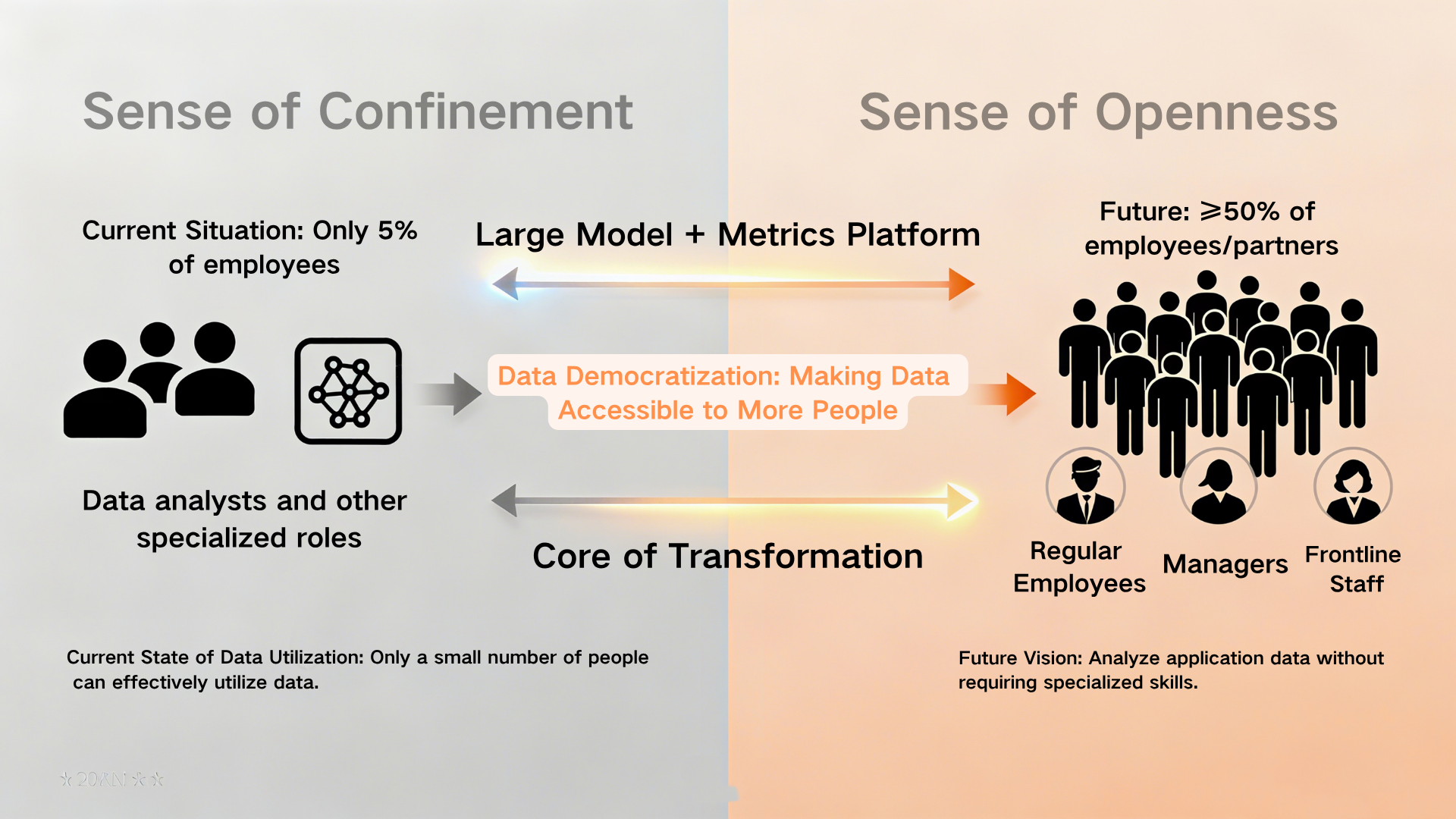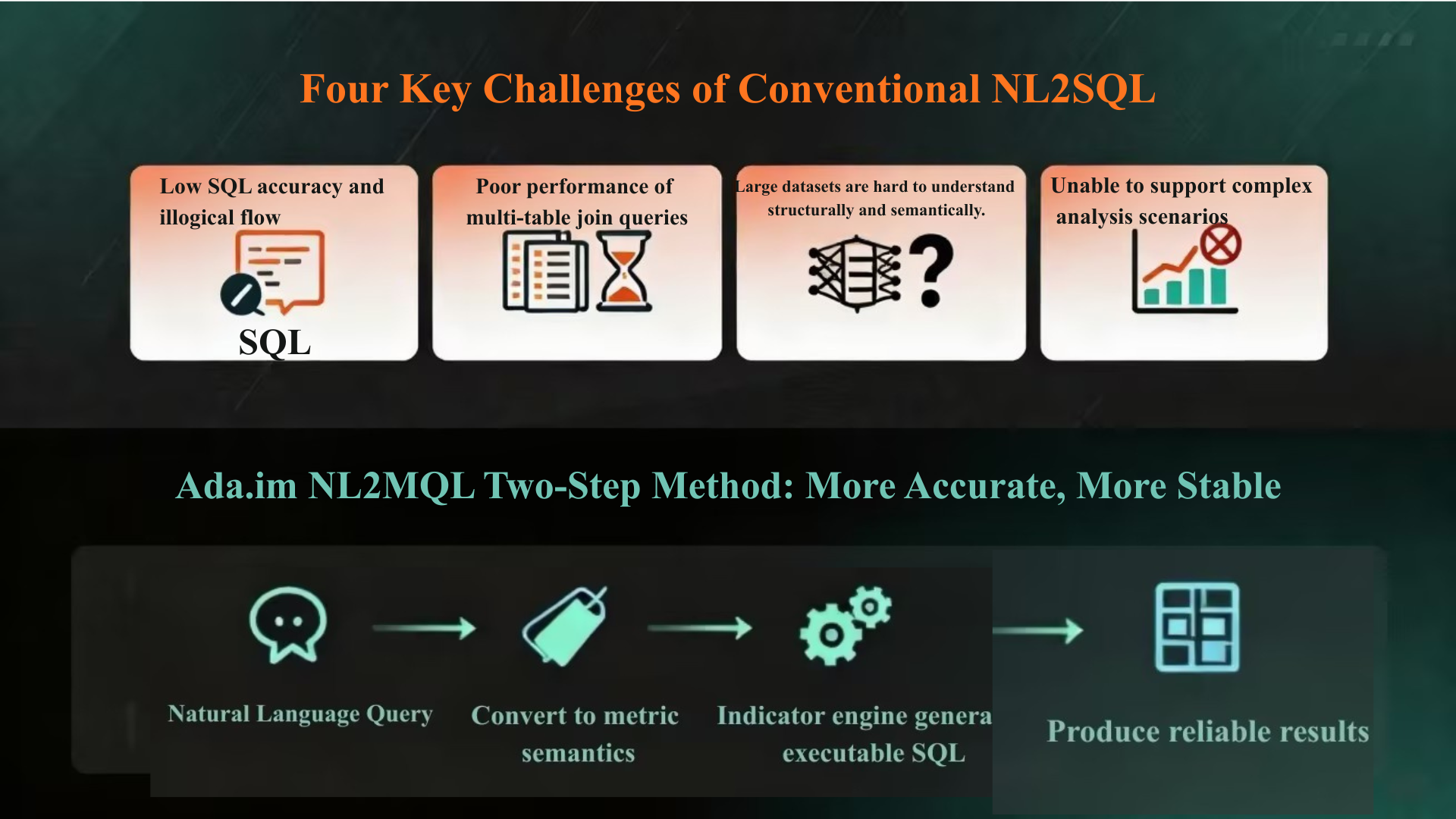Application of Large Models and Metrics Platforms
Keywords: Large Models, Metrics Platform, Data Democratization, NL2MQL, Intelligent Analytics
Executive summary
Large models and metrics platforms are essential for data intelligence. Shirley, VP at Ada.im, shared how combining LLMs with a metrics platform raises effective data usage from ~5% to 50%+ of employees. Ada.im’s NL2MQL delivers more accurate, stable queries than traditional NL2SQL, with success in retail, automotive, and finance.
Exploring LLM applications in data analysis
Ada.im’s intelligent analytics assistant leverages LLMs to enable interactive queries, root-cause analysis, and automated reports, improving speed and accuracy.
The power of natural language analytics
Staff and managers access data via conversation, producing analyst-grade reports to support strategic decisions.
“Large language models are not just about technology—they're about democratizing access to insights that were previously locked away from most employees.” — Shirley
LLMs + metrics platforms bring data to more people
From 5% to 50%+ engagement

- Faster decisions at the point of action
- Better insights by those closest to the problem
- Reduced bottlenecks for analytics teams
- Competitive advantage through broad data leverage
NL2MQL improves accuracy with large data
Problems with NL2SQL
Direct NL2SQL often yields inaccurate SQL, struggles with multi-table joins, and falters on advanced analytics.
Two-step NL2MQL approach
- Natural language → metric semantics mapped to a standardized catalog
- Metric semantics → optimized SQL via a metric engine

Technical advantages
- Accuracy: 95%+ for complex queries
- Consistency: Standardized definitions
- Speed: Optimized execution
- Advanced analytics: Forecasting, attribution, simulation
- Maintenance: Resilient to schema changes
Key insight: Separating business semantics from technical implementation ensures queries keep working as schemas evolve.
Case studies across industries
Retail: Beverage chain
- Automated analytics processes
- Improved quality via consistent metrics
- Real-time decisions by store managers
- Analyst focus shift to strategic work
Automotive
- Production metrics in real-time
- Automated quality analysis
- Supply chain optimization
- Dealer performance management
Financial services
- Regulatory reporting with audit trails
- Risk analytics and portfolio monitoring
- Customer analysis and personalization
- Fraud detection and anomaly identification
- Time savings: 70–90% reduction
- Decision quality: improved via broader access
- Employee satisfaction: higher due to fewer barriers
- Business impact: faster market response
The path forward
Standards participation
Open collaboration and standards-based approaches for interoperability and accessible innovation.
Continuous innovation
- Enhanced NL understanding
- Expanded analytical capabilities
- Industry-specific intelligence
- Performance at scale
Key takeaways
- Data democratization: critical for competitiveness
- LLM + metrics platform: practical AI value
- NL2MQL: solves enterprise accuracy and reliability
- Proven success: retail, automotive, finance
- Standards: reduce risk and lock-in
Quantifying business value
Operational efficiency
- Analyst productivity: +70–90%
- Report generation: automated
- Decision speed: minutes instead of days
Strategic advantages
- Market responsiveness
- Competitive intelligence
- Innovation acceleration
Financial returns
- Cost savings
- Revenue growth
- Risk reduction
Organizational transformation
- Data-driven culture
- Higher satisfaction
- Broader analytical skill
Getting started: Journey to data democratization
Phase 1: Assessment and planning (Weeks 1–4)
- Current state: access patterns, bottlenecks, impact
- Vision: utilization targets, use cases, success metrics, ROI
Phase 2: Foundation building (Weeks 5–12)
- Metrics infrastructure: catalog, unified definitions, governance
- LLM capabilities: NL2MQL assistant, terminology, integration
Phase 3: Pilot and refinement (Weeks 13–20)
- Controlled pilot: training, feedback, iteration
- Measure & optimize: usage, best practices
Phase 4: Scale and sustain (Weeks 21+)
- Rollout: training, community of practice, monitoring
- Continuous improvement: new use cases, advanced analytics
About Ada.im
- Solutions: Intelligent Analytics Assistant, Unified Metrics Platform, NL2MQL, industry modules
- Website: ada.im
- Contact: contact@ada.im
Topics: #LargeModels #MetricsPlatform #DataDemocratization #NL2MQL #IntelligentAnalytics #NaturalLanguageAnalytics #BusinessIntelligence #DigitalTransformation #EnterpriseData